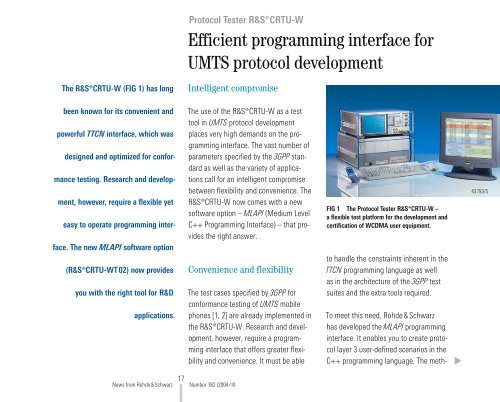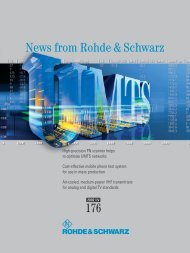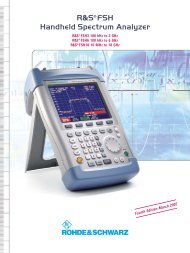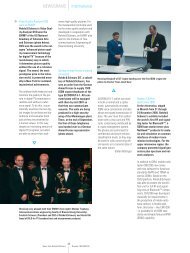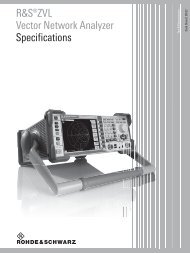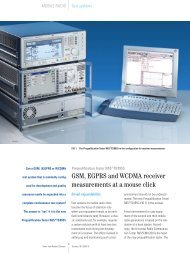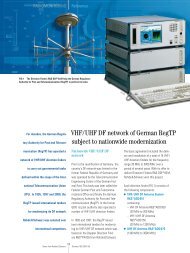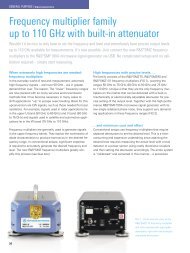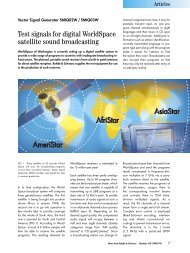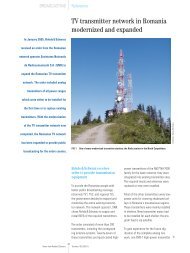Efficient programming interface for UMTS ... - Rohde & Schwarz
Efficient programming interface for UMTS ... - Rohde & Schwarz
Efficient programming interface for UMTS ... - Rohde & Schwarz
Create successful ePaper yourself
Turn your PDF publications into a flip-book with our unique Google optimized e-Paper software.
Protocol Tester R&S ® CRTU-W<br />
<strong>Efficient</strong> <strong>programming</strong> <strong>interface</strong> <strong>for</strong><br />
<strong>UMTS</strong> protocol development<br />
The R&S ® CRTU-W (FIG 1) has long<br />
Intelligent compromise<br />
been known <strong>for</strong> its convenient and<br />
powerful TTCN <strong>interface</strong>, which was<br />
designed and optimized <strong>for</strong> con<strong>for</strong>mance<br />
testing. Research and development,<br />
however, require a flexible yet<br />
easy to operate <strong>programming</strong> <strong>interface</strong>.<br />
The new MLAPI software option<br />
(R&S ® CRTU-WT02) now provides<br />
you with the right tool <strong>for</strong> R&D<br />
applications.<br />
The use of the R&S ® CRTU-W as a test<br />
tool in <strong>UMTS</strong> protocol development<br />
places very high demands on the <strong>programming</strong><br />
<strong>interface</strong>. The vast number of<br />
parameters specified by the 3GPP standard<br />
as well as the variety of applications<br />
call <strong>for</strong> an intelligent compromise<br />
between flexibility and convenience. The<br />
R&S ® CRTU-W now comes with a new<br />
software option – MLAPI (Medium Level<br />
C++ Programming Interface) – that provides<br />
the right answer.<br />
Convenience and flexibility<br />
The test cases specified by 3GPP <strong>for</strong><br />
con<strong>for</strong>mance testing of <strong>UMTS</strong> mobile<br />
phones [1, 2] are already implemented in<br />
the R&S ® CRTU-W. Research and development,<br />
however, require a <strong>programming</strong><br />
<strong>interface</strong> that offers greater flexibility<br />
and convenience. It must be able<br />
FIG 1 The Protocol Tester R&S ® CRTU-W –<br />
a flexible test plat<strong>for</strong>m <strong>for</strong> the development and<br />
certification of WCDMA user equipment.<br />
to handle the constraints inherent in the<br />
TTCN <strong>programming</strong> language as well<br />
as in the architecture of the 3GPP test<br />
suites and the extra tools required.<br />
To meet this need, <strong>Rohde</strong> & <strong>Schwarz</strong><br />
has developed the MLAPI <strong>programming</strong><br />
<strong>interface</strong>. It enables you to create protocol<br />
layer 3 user-defined scenarios in the<br />
C++ <strong>programming</strong> language. The meth-<br />
43793/5<br />
17<br />
News from <strong>Rohde</strong> & <strong>Schwarz</strong> Number 182 (2004/II)
MOBILE RADIO<br />
Protocol testers<br />
ods of handling protocol messages as<br />
well as the modelling of dynamic operation<br />
cover a wide range of applications,<br />
from simple to very powerful. For<br />
example, you might want to set a mobile<br />
phone to a defined signalling state by<br />
using a simple sequence of messages<br />
and then implement a desired application<br />
in this state. Or, you might employ<br />
complex alternatives or deliberately<br />
cause a faulty response in order to test<br />
the signalling function.<br />
Concept of automatic<br />
configuration<br />
Due to the quality of service (QoS) architecture<br />
of the <strong>UMTS</strong> standard, higher<br />
protocol layers request the transmission<br />
quality <strong>for</strong> a specific application<br />
in abstract <strong>for</strong>m, whereas the actual<br />
parameters <strong>for</strong> channel configuration<br />
are known only in the lower layers<br />
(referred to as access stratum, AS).<br />
These parameters are very numerous,<br />
however, and can be combined in a variety<br />
of ways. <strong>UMTS</strong> differs from GSM in<br />
that the top AS layer, i.e. the RRC [3], is<br />
responsible <strong>for</strong> managing these parameters<br />
and their combinations. The strategy<br />
<strong>for</strong> assigning these parameters is<br />
implemented by the network operator.<br />
The parameter in<strong>for</strong>mation is coded<br />
as RRC protocol data (PDUs) using complex<br />
elements described in the ASN.1<br />
language and transmitted to the mobile<br />
phone. The base station and the mobile<br />
phone must configure their lower protocol<br />
layers accordingly be<strong>for</strong>e data can be<br />
transmitted at the required QoS (FIG 2).<br />
Similar processes take place during handover<br />
and other main procedures.<br />
In contrast to other layer 3 messages,<br />
the RRC PDUs there<strong>for</strong>e contain in<strong>for</strong>mation<br />
not only <strong>for</strong> the peer station but<br />
also <strong>for</strong> local configuration. The configuration<br />
<strong>interface</strong>s of the lower layers are<br />
usually proprietary, whereas the RRC<br />
PDU is defined by the 3GPP standard [3].<br />
Since users of the C++ <strong>programming</strong><br />
<strong>interface</strong> are usually interested in the<br />
detailed definition and full flexibility of<br />
the RRC PDU covering all parameters<br />
rather than in the complex configuration<br />
of the lower layers, offering the actual<br />
RRC PDU as a “single-source” <strong>interface</strong><br />
is a good approach.<br />
As a result, the MLAPI protocol stack<br />
provided by <strong>Rohde</strong> & <strong>Schwarz</strong> contains<br />
not only the lower protocol layers<br />
but also the part of the RRC layer that<br />
is responsible <strong>for</strong> the configuration of<br />
the lower layers, hence the designation<br />
“Medium Level“. Thus, when you<br />
send an RRC PDU from your scenario,<br />
the required in<strong>for</strong>mation is automatically<br />
extracted and passed on to the lower<br />
layers. This considerably reduces error<br />
rate and program size without any loss<br />
of flexibility.<br />
New dimensions in protocol<br />
message handling<br />
The basic software <strong>for</strong> the R&S ® CRTU-W<br />
provides a library (MDDB) <strong>for</strong> handling<br />
protocol messages. The library is automatically<br />
generated from the message<br />
specifications and includes all methods<br />
of handling such messages. For example,<br />
the Message Analyzer uses the MDDB<br />
to completely decode recorded protocol<br />
messages and interpret subelement<br />
values in text <strong>for</strong>m.<br />
All MDDB methods are available <strong>for</strong> the<br />
C++ pogramming <strong>interface</strong>, including<br />
read and write access to any desired<br />
subelements, cloning of substructures,<br />
reading and storage of message<br />
instances – in hexadecimal or XML<br />
<strong>for</strong>mat – and many more. Simple macros<br />
are available <strong>for</strong> transmitting and receiving<br />
any layer 3 PDU.<br />
Being able to define message instances<br />
is one of the <strong>programming</strong> <strong>interface</strong>‘s<br />
main features. There<strong>for</strong>e, a graphical<br />
tool which is also based on the MDDB<br />
has been implemented <strong>for</strong> this purpose<br />
– the Message Composer (FIG 4). This<br />
tool enables you to conveniently per<strong>for</strong>m<br />
any modifications to the scenario behaviour<br />
that are coded in the protocol messages<br />
without having to recompile the<br />
scenario.<br />
To allow received messages to be<br />
checked against predefined receive constraints,<br />
they are not stored in purely<br />
hexadecimal <strong>for</strong>mat. Rather, they must<br />
support wildcards that, <strong>for</strong> example,<br />
allow a defined list of values or any<br />
value (ANY) to be assumed by a specific<br />
subelement. These values can also be<br />
graphically defined with the Message<br />
Composer and are highlighted in colour<br />
(FIG 4). The C++ <strong>programming</strong> <strong>interface</strong><br />
also offers a simple macro that per<strong>for</strong>ms<br />
the comparison automatically. If there is<br />
no match, the discrepancy will be indicated<br />
in the subelement tree.<br />
Intelligent organization of<br />
dynamic behaviour<br />
The MLAPI offers simple macros <strong>for</strong><br />
defining state machines to enable efficient<br />
<strong>programming</strong> even <strong>for</strong> complex,<br />
branched operations. The reception of a<br />
message – or more generally speaking<br />
an event – is represented by a transition<br />
within a state. If and to what extent different<br />
states or state machines are actually<br />
used is up to you.<br />
Further powerful functions are available<br />
<strong>for</strong> optimizing scenario modularity.<br />
State machines can be run in parallel<br />
or be derived from one another, making<br />
it easy <strong>for</strong> you to define a common<br />
means of handling exceptions <strong>for</strong> a specific<br />
number of procedures, <strong>for</strong> example.<br />
Moreover, state machines can mutually<br />
call each other, allowing you to design<br />
a procedure-oriented scenario. The <strong>programming</strong><br />
<strong>interface</strong> further provides convenient<br />
means of defining timers, delays,<br />
18<br />
News from <strong>Rohde</strong> & <strong>Schwarz</strong> Number 182 (2004/II)
FIG 3<br />
FIG 2<br />
QoS and <strong>UMTS</strong><br />
protocol structure.<br />
<br />
<br />
<br />
<br />
<br />
<br />
<br />
<br />
<br />
<br />
<br />
<br />
<br />
<br />
<br />
<br />
<br />
Modularization of the dynamic behaviour of a scenario.<br />
<br />
<br />
<br />
<br />
<br />
<br />
<br />
<br />
<br />
<br />
<br />
<br />
<br />
<br />
<br />
<br />
<br />
<br />
Important abbreviations<br />
3GPP<br />
AMR<br />
AS<br />
ASN.1<br />
CS<br />
EMMI<br />
HSDPA<br />
IP<br />
MAC<br />
MDDB<br />
MLAPI<br />
MMS<br />
PDCP<br />
PDU<br />
PS<br />
QoS<br />
RAT<br />
RLC<br />
RRC<br />
TTCN<br />
<strong>UMTS</strong><br />
WAP<br />
3rd Generation Partnership<br />
Project<br />
Adaptive Multirate<br />
Access Stratum<br />
Abstract Syntax Notation<br />
One<br />
Circuit Switched<br />
Electrical Man-Machine<br />
Interface<br />
High Speed Downlink<br />
Packet Access<br />
Internet Protocol<br />
Medium Access Control<br />
Message Description Data<br />
Base<br />
Medium Level C++ Programming<br />
Interface<br />
Multimedia Message<br />
Service<br />
Packet Data Convergence<br />
Protocol<br />
Protocol Data Unit<br />
Packet Switched<br />
Quality of Service<br />
Radio Access Technology<br />
Radio Link Control<br />
Radio Resource Control<br />
Tree and Tabular Combined<br />
Notation<br />
Universal Mobile Telecommunications<br />
System<br />
Wireless Application<br />
Protocol<br />
FIG 4<br />
Message Composer with<br />
receive constraints check.<br />
19<br />
News from <strong>Rohde</strong> & <strong>Schwarz</strong> Number 182 (2004/II)
MOBILE RADIO<br />
Protocol testers<br />
triggers, as well as the parameterization<br />
<strong>for</strong> passing messages or other in<strong>for</strong>mation<br />
to additional state machines.<br />
The MLAPI software option already contains<br />
a number of example scenarios<br />
in the <strong>for</strong>m of compilable source code.<br />
These scenarios show how to use all<br />
essential <strong>interface</strong> elements. They also<br />
implement standard applications such<br />
as CS registration and PS attach, AMR<br />
speech call, PS data call, CS/PS multicall,<br />
soft and hard handover. Being of<br />
modular design (FIG 3), the scenarios<br />
can easily be expanded. To make this<br />
possible, the state model described in<br />
the 3GPP test specification [4] has been<br />
expanded to create a modular system.<br />
All actions carried out by macros of the<br />
<strong>programming</strong> <strong>interface</strong> are written to a<br />
log file that can be decoded by the Message<br />
Analyzer. This keeps you constantly<br />
in<strong>for</strong>med of what is happening – in the<br />
state involved and the scenario activity<br />
– in the lower protocol layers. You can<br />
also send in<strong>for</strong>mation of your own to the<br />
log file while your scenario is running.<br />
Tools and peripherals<br />
Summary and future<br />
developments<br />
The MLAPI is a tool <strong>for</strong> <strong>UMTS</strong> protocol<br />
development that optimally combines<br />
flexibility with convenience. Due to the<br />
unique <strong>interface</strong> design, test scenarios<br />
can be created with considerably less<br />
ef<strong>for</strong>t. The concept of automatic configuration<br />
of the lower protocol layers further<br />
contributes to efficiently generating<br />
and maintaining test scenarios. Plus, you<br />
can easily integrate your own protocol<br />
behaviour into the C++ program source<br />
code that is supplied. This enables you<br />
to simulate incorrect protocol behaviour,<br />
<strong>for</strong> example.<br />
More in<strong>for</strong>mation and data sheet<br />
at www.rohde-schwarz.com<br />
(search term: CRTU-W)<br />
The versatile capabilities of the base<br />
unit are also reflected by the <strong>programming</strong><br />
<strong>interface</strong>. The convenient use of IPbased<br />
data services (http, WAP, audio/<br />
video streaming, MMS) and video conferences<br />
will soon be possible, as well<br />
as the scaling of several protocol testers<br />
<strong>for</strong> multicell and handover scenarios.<br />
Moreover, <strong>Rohde</strong> & <strong>Schwarz</strong> plans<br />
to expand the <strong>programming</strong> <strong>interface</strong> to<br />
enable you to control a Protocol Tester<br />
R&S ® CRTU-G using the same philosophy<br />
as <strong>for</strong> the R&S ® CRTU-W. This will allow<br />
you to define 2G3 inter-RAT handover<br />
scenarios [6].<br />
<strong>Rohde</strong> & <strong>Schwarz</strong> increasingly offers<br />
packages of ready-to-run scenarios that<br />
simulate typical applications in real networks,<br />
i.e. applications in the field of<br />
interoperability testing.<br />
Future expansions include the HSDPA<br />
standard, <strong>interface</strong>s <strong>for</strong> stimulating a<br />
specific behaviour in layer 2, and a convenient<br />
graphical user <strong>interface</strong> <strong>for</strong> interactively<br />
creating scenarios from existing<br />
procedures.<br />
Stephan Sandhäger<br />
The generated programs run under<br />
Windows® 2000; the <strong>programming</strong><br />
<strong>interface</strong> is integrated into Microsoft®<br />
VisualStudio .NET© IDE. User-created<br />
scenarios can be organized by<br />
means of the TestSuite Explorer and<br />
Project Explorer tools included in the<br />
R&S ® CRTU-W basic software. An example<br />
project is also supplied.<br />
The MLAPI supports linking to the EMMI,<br />
enabling automatic control of the mobile<br />
phone by means of AT commands [5]. It<br />
also allows preliminary and final verdicts<br />
to be output like in con<strong>for</strong>mance testing.<br />
The above functions employ the same<br />
modules as those used in the TTCN test<br />
cases.<br />
REFERENCES<br />
[1] 3GPP TS34.123: 3GPP Radio Access<br />
Network – User Equipment (UE) Con<strong>for</strong>mance<br />
Specification<br />
[2] Protocol Tester R&S ® CRTU-W: Futureproof<br />
tool <strong>for</strong> testing WCDMA terminals.<br />
News from <strong>Rohde</strong> & <strong>Schwarz</strong> (2002)<br />
No. 175, pp 4–7<br />
[3] 3GPP TS25.331: 3GPP Radio Access Network<br />
– Radio Resource Control (RRC)<br />
Protocol Specification<br />
[4] 3GPP TS34.108: 3GPP Radio Access<br />
Network – Common Test Environments<br />
<strong>for</strong> User Equipment (UE) Con<strong>for</strong>mance<br />
Testing<br />
[5] 3GPP TS34.109: 3GPP Radio Access Network<br />
– Terminal Logical Test Interface;<br />
Special Con<strong>for</strong>mance Testing Functions<br />
[6] Protocol Tester R&S ® CRTU-G/-W: 2 in 1:<br />
Software option <strong>for</strong> 2G/3G system simulation.<br />
News from <strong>Rohde</strong> & <strong>Schwarz</strong><br />
(2003) No. 178, pp 22–24<br />
20<br />
News from <strong>Rohde</strong> & <strong>Schwarz</strong> Number 182 (2004/II)


